Melsittamur
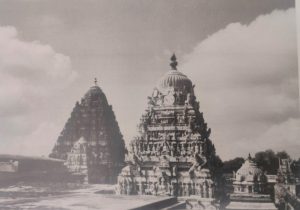 (left). General view of the towers of the ‘new’ (16th cent.) temple of Melsittamur as seen from the roof of a nearby build- ing. The two old templs (9th cent.), housing sev- eral impressive sculptures, lie a short way beyond the blackened tower.
(left). General view of the towers of the ‘new’ (16th cent.) temple of Melsittamur as seen from the roof of a nearby build- ing. The two old templs (9th cent.), housing sev- eral impressive sculptures, lie a short way beyond the blackened tower.
(far left below). Sculpture on a pillar facing from within the main entrance of the v’ temple.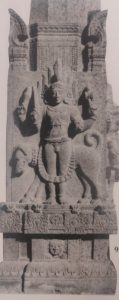 It repre- ‘new’ sents Bhairava with the dog functioning as the kshetrapala of the place. Kshetrapalas are guardian spirits protecting a temple or village compound.
It repre- ‘new’ sents Bhairava with the dog functioning as the kshetrapala of the place. Kshetrapalas are guardian spirits protecting a temple or village compound.
 (left below). Goddess Ganga on a doorway jamb of the main temple. 97 (right). The massive tower of Melsittamur’s main temple, adorned with Jinas. In front of it a flagstaff and a mana- stambha.
(left below). Goddess Ganga on a doorway jamb of the main temple. 97 (right). The massive tower of Melsittamur’s main temple, adorned with Jinas. In front of it a flagstaff and a mana- stambha.
To reach the village of Melsittamur, board any morning bus at Gingee bound for Tindi- vanam and alight at the eastern end of Vellam village; a ride of just ten kilometres. From there it is a delightful half-an-hour’s walk northwards past rice-fields at different stages of cultivation.
At one point, however, it means wet feet as a shallow brook needs to be waded through.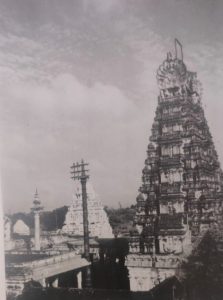 The temples and the Jaina Matha, a stately building, are located at the further end of the village.
The temples and the Jaina Matha, a stately building, are located at the further end of the village.
It is advisable to pay one’s respects to the Bhattaraka, Shri Swamigal Lakshmisena, and ask for permission to take photographs. Once a year, in the month of April, Melsittamur has a Jaina temple-car festival, lasting for ten days.
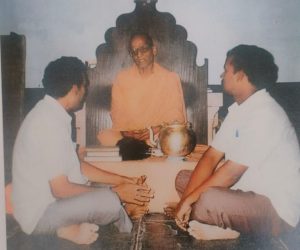 The Bhattaraka of Melsittamur with two visitors from Gingee. Note the items displayed on the table before him – some books, a fly-whisk made of peacock feathers, a metal water-jug – and compare them with those depicted on the pedestal of the
The Bhattaraka of Melsittamur with two visitors from Gingee. Note the items displayed on the table before him – some books, a fly-whisk made of peacock feathers, a metal water-jug – and compare them with those depicted on the pedestal of the
image of a Bhattaraka (above). The book-stand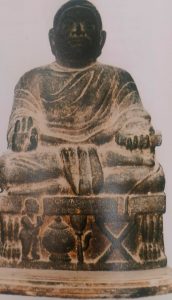 symbolises the scriptures which a Bhattaraka is expected to study. Images of these Digambara pontiffs are very rare. This one kept by Bhatta- raka Laxmisena in his room.
symbolises the scriptures which a Bhattaraka is expected to study. Images of these Digambara pontiffs are very rare. This one kept by Bhatta- raka Laxmisena in his room.
Ponnur Hill. Once a year the rock- carved footprints of Acharya 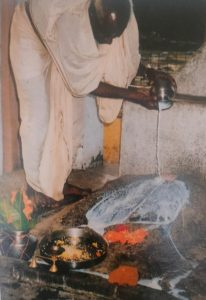 Kundakunda at the top of the hill are ceremoniously wor- shipped. There is a Jaina school at the foot of the hill; and recently a printing and mechanical training centre has been built and named after Acharya Kundakunda.
Kundakunda at the top of the hill are ceremoniously wor- shipped. There is a Jaina school at the foot of the hill; and recently a printing and mechanical training centre has been built and named after Acharya Kundakunda.
This great Jaina monk and author, who is accepted by both the Digam- baras and Shvetambaras, was born in this area some time in the second or third century AD.
Every day anew, the Jina images in temples or private puja-rooms must be lustrated”,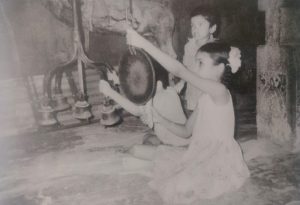 otherwise they lose their spiritual value. Here, in a Tamilnadu Jaina temple, the musical accompaniment to this sacred rite is provided by the attentive children of the pujari (Tamil – vathar).
otherwise they lose their spiritual value. Here, in a Tamilnadu Jaina temple, the musical accompaniment to this sacred rite is provided by the attentive children of the pujari (Tamil – vathar).
Viranamur; a village with some forty Jaina families. The picture was taken on a day late in December  when traditional- ly 365 oil-lamps are lighted in the local temple to the singing of hymns by the assembled congregation. The lights are kept burning till about January the 15th. A custom peculiar to the Tamil Jainas.
when traditional- ly 365 oil-lamps are lighted in the local temple to the singing of hymns by the assembled congregation. The lights are kept burning till about January the 15th. A custom peculiar to the Tamil Jainas.
Lustrate- v.t. Purify by expiatory sacrifice, ceremonial washing, or other such rite (The Concise Oxford Dictionary).
